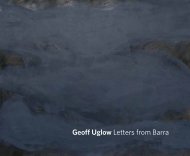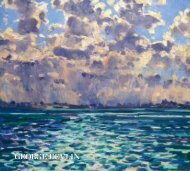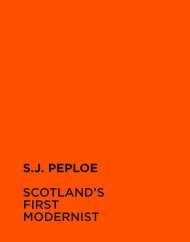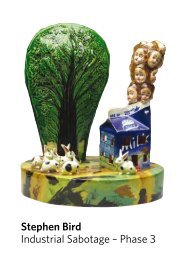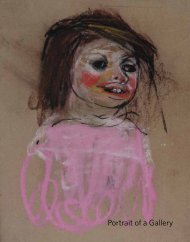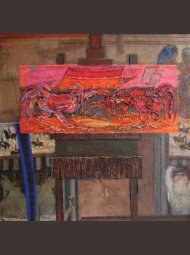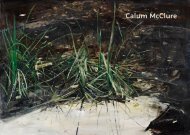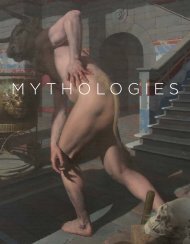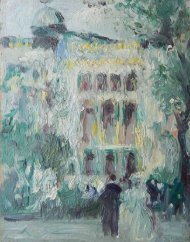Download a PDF of the exhibition catalogue - The Scottish Gallery
Download a PDF of the exhibition catalogue - The Scottish Gallery
Download a PDF of the exhibition catalogue - The Scottish Gallery
Create successful ePaper yourself
Turn your PDF publications into a flip-book with our unique Google optimized e-Paper software.
and Explanatory Notes on <strong>the</strong> Art <strong>of</strong> Mr William McTaggart as Displayed in his Exhibition <strong>of</strong> Thirtytwo<br />
Pictures in 1901. <strong>The</strong> overall impression from <strong>the</strong> notes is expressed clearly by Dott<br />
in his statement that ‘In Art, colour and light are certainly measures <strong>of</strong> higher faculties in<br />
<strong>the</strong> artist than form.’ He commends McTaggart’s works to <strong>the</strong> untutored in painting for<br />
<strong>the</strong>ir sheer ‘bonniness’. We cannot censure <strong>the</strong> salesman for his hagiography, but clearly<br />
Dott’s passion for McTaggart was genuine, and such commendations supported Blyth’s<br />
own judgement which was initially based on immediate appeal ra<strong>the</strong>r than analysis.<br />
In 1954 Blyth wrote <strong>the</strong> introduction to an <strong>exhibition</strong> <strong>of</strong> works by McTaggart<br />
at <strong>the</strong> Royal <strong>Scottish</strong> Academy. Blyth selected all <strong>the</strong> works for <strong>the</strong> <strong>exhibition</strong>, and<br />
contributed 23 works from his collection, dating from Dora <strong>of</strong> 1866 to Cornfield, Sandy<br />
Dean <strong>of</strong> 1905. He wrote: ‘McTaggart’s impressionism was inborn and spontaneous.<br />
It was not influenced by any <strong>the</strong>ories or dogmas, and he was unaware <strong>of</strong> <strong>the</strong> movement<br />
in France.’ Blyth also dwells on McTaggart’s background and education: ‘Whence came<br />
that talent is a mystery … this lad from a cr<strong>of</strong>t at <strong>the</strong> extreme corner <strong>of</strong> <strong>the</strong> Mull <strong>of</strong><br />
Kintyre pursued his own course and became <strong>the</strong> first and foremost Impressionist painter<br />
in Scotland.’ Likewise Blyth had no artistic background, and where his fascination for<br />
art came from is equally a mystery. Thus <strong>the</strong>re were close links between <strong>the</strong> artist and<br />
collector which Blyth perhaps was aware <strong>of</strong> and enjoyed.<br />
McTaggart’s most ambitious and monumental works can still be read as genre or<br />
history painting, but his figures are increasingly subsumed into <strong>the</strong> landscape, as Blyth<br />
himself notes:<br />
McTaggart’s use <strong>of</strong> figures in his composition is one <strong>of</strong> <strong>the</strong> most fascinating<br />
features <strong>of</strong> his art. <strong>The</strong>y are always part <strong>of</strong> <strong>the</strong> impression. In some cases<br />
<strong>the</strong> impression is a strong one, in o<strong>the</strong>rs it is more fleeting, or it may be<br />
so slight that <strong>the</strong> figures appear only as notes <strong>of</strong> lovely colour.<br />
<strong>The</strong> handling is vital and <strong>the</strong>re is a great, raw energy perhaps at its most dramatic<br />
when McTaggart paints <strong>the</strong> sea exemplified in Blyth’s most expensive acquisition, White<br />
Surf <strong>of</strong> 1908, purchased in 1920. <strong>The</strong> artist can work as successfully on a heroic or tiny<br />
scale, and <strong>the</strong> subtle play <strong>of</strong> light on broken water is beautifully handled in many small<br />
works such as Sunset at Machrihanish (page 33). Blyth recognised that <strong>the</strong> seascapes were<br />
deemed more successful than <strong>the</strong> landscapes, writing: ‘McTaggart’s pictures <strong>of</strong> <strong>the</strong> sea<br />
are <strong>the</strong> most wonderful ever painted, and his supremacy in this branch <strong>of</strong> art is apt to<br />
minimise <strong>the</strong> interest in his landscapes.’<br />
As well as works by McTaggart, Blyth consistently bought works by James<br />
Lawton Wingate. If McTaggart is a Scots Turner <strong>the</strong>n Wingate has to be considered a petit<br />
maître who owes his vision to Corot and <strong>the</strong> French painters <strong>of</strong> <strong>the</strong> Barbizon School. Blyth<br />
did not include work <strong>of</strong> <strong>the</strong> nineteenth-century Hague School, which was immensely<br />
popular with <strong>Scottish</strong> collectors and influential on <strong>the</strong> landscapes and genre works <strong>of</strong><br />
many senior Academicians such as Robert Macgregor and Robert Gemmell Hutchison.<br />
He was not interested in genre painting per se but more drawn to depictions <strong>of</strong> <strong>the</strong> natural<br />
world, which might contain an element <strong>of</strong> sentimentality, but are essentially truthful to<br />
<strong>the</strong>ir subject. In this sense Wingate’s ability to capture a time <strong>of</strong> day within a season<br />
and (sometimes) to include a working horse or a labourer chimed with his own sense<br />
<strong>of</strong> emotional engagement with <strong>the</strong> <strong>Scottish</strong> landscape. Today perhaps we can see more<br />
clearly how McTaggart was able to tap into universal emotions, while Wingate seems<br />
to belong to an essentially nineteenth-century vision untouched by modernism; but his<br />
ability to render a time and place cannot be dismissed. Typically loyal and consistent,<br />
Blyth certainly thought <strong>of</strong> his Wingate works as amongst his most treasured pictures:<br />
9



